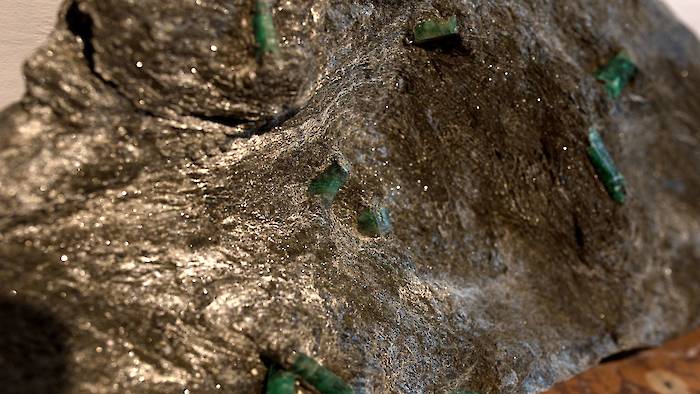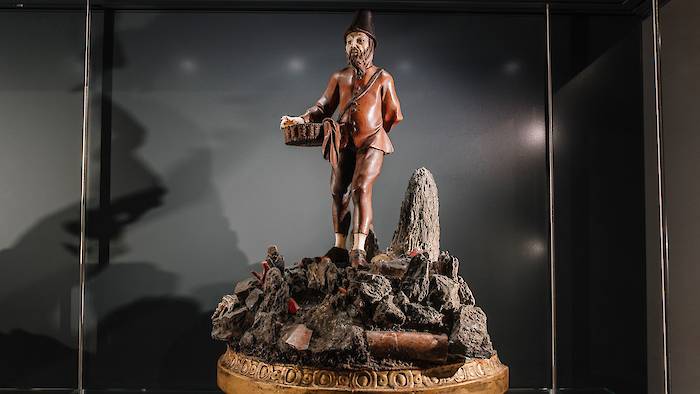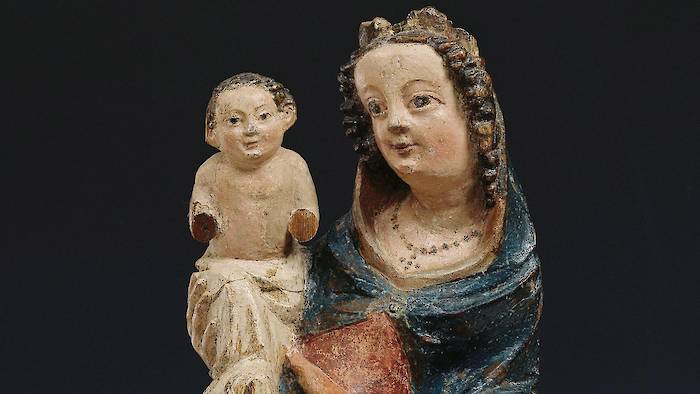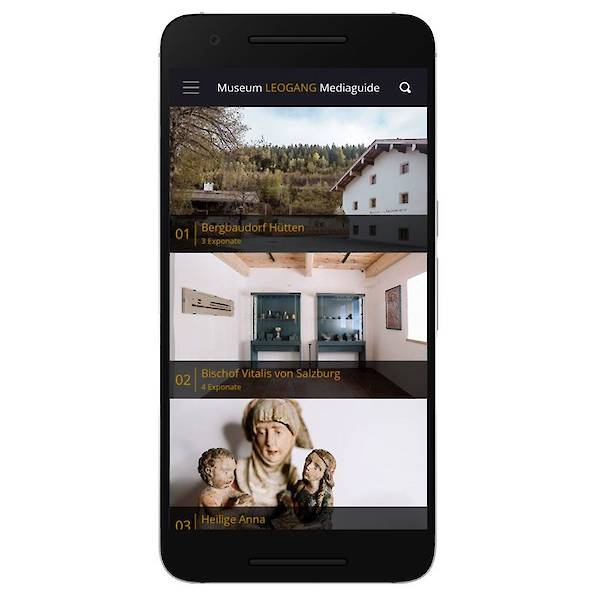A selection of our current exhibits
-
Emeralds from HabachtalGlittering jewel
 Emeralds from HabachtalGlittering jewel
Emeralds from HabachtalGlittering jewelThe emerald source in the Habachtal valley, at Bramberg in Oberpinzgau, is the only significant occurrence of emeralds in Central Europe and has been known since 1669.
Duchess Anna Maria de Medici mentioned the emerald mine in a letter to her brother Gian Gastone, the last Grand Duke Medici of Tuscany, at the beginning of the 18th century, in reference to a report by the Danish priest and naturalist Niels Stensen.
Favourable geological conditions have allowed emeralds to form in the talcose mica schist over the millennia. The six-sided beryls, which, structurally, belong to the cyclosilicates group, were coloured green by chromium. The more chromium there is in the beryl, the more intensive the green.
Seven Habachtal emeralds were set into Abbot Albert Nagnzaun’s splendid pectoral cross in 1786. Nagnzaun, as Albert IV, was abbot of St. Peter’s Abbey from 1818 until his death in 1856. The pectoral cross is now kept in St. Peter’s.
Alois Steiner, a geologist from Bramberg, was able to make a significant discovery when he split open talcose schist rock to find a 40 cm mineral layer with 24 nearly pure, deep green emeralds. It was in the shape of the Madonna and is known as the Emerald Madonna (TXTL1) today. This layer of emeralds can be admired in the Museum Bramberg in the national park exhibition Emeralds and Crystals.
At 2200 m above sea level, a total of four tunnels were made in the mountain over the course of its colourful mining history, of which only one is still used for maintenance work. The entire site belongs to a lawyer family from Munich; entering the tunnels is prohibited without exception because of the risk of falling rocks
Over the millennia, the emeralds have become scattered in the slip rock due to erosion. With a certain level of patience they can be found next to or above the Alpenrose inn in the Habachtal valley with relatively little danger involved.
-
Pannier carriers by Simon TrogerPinnacle of Baroque mountain art
 Pannier carriers by Simon TrogerPinnacle of Baroque mountain art
Pannier carriers by Simon TrogerPinnacle of Baroque mountain artThe so-called hand stones represent the pinnacle of Baroque and Late Baroque mountain art. Hand stones are particularly beautiful pieces of crystallised mineral or ore with subjects added from miners’ everyday life, resting on costly bases. There are hardly more than a dozen of these rare examples of mountain art left in the world.
The cabinet of mountain curiosities at the Leogang Mining and Gothic Museum has two hand stones with added pannier carriers on display, created by Simon Troger in his Tyrolean workshop in the 18th century.
First there is a large figure with a hat, its face made from ivory or bone, walking on a hill made of minerals and stone. You can recognise smoky quartz, mica schist and actinolite (from the Greek for ‘shining stone’) but also a small piece of amethyst, polished carnelian and fossilised snails and corals. The hand stone and figure rests on a wooden, contoured base.
The second hand stone from the workshop of the Tyrolean master craftsman is similar: a mineral and stone hill on a semi-circular carved gilt base. Here too can be found smoky quartz, pieces of marble, a typically tapered actinolite, polished carnelian and fossilised coral and mussels. On the top is a large figure with a tall hat, its face and hands made of ivory or bone.
Both hand stones are on loan from the Spängler bank in Salzburg.
-
Lion MadonnaRare masterpiece
 Lion MadonnaRare masterpiece
Lion MadonnaRare masterpieceMadonnas standing or enthroned upon a lion are very rare. The first of these sculptures probably date back to the early period of Emperor Charles IV in the first half of the 14th century.
The sculpture on display at the Leogang Mining and Gothic Museum is one of an exclusive circle of Salzburg Lion Madonnas, to which only six others in the world belong. One is in Bachschmiede in Wals near Salzburg, two are at the Bavarian National Museum in Munich, one is in private ownership in Hamburg, one is in Berlin’s Bode Museum and the sixth can be found at the Louvre in Paris.
The Lion Madonna at the Leogang Mining and Gothic Museum was created around 1370 in pine wood. The description of the Lion Madonna is basically consistent with the older Lion Madonna in the Bavarian National Museum. With her crown and the now-missing sceptre in her left hand, she represented the Queen of Heaven. The falling veil, which seems to be buttoned over her chest, only covers the crown of her head, the curls on either side of her face remaining exposed.
An archaic smile lightens up her face and that of the Infant Jesus. She stands in a distinctive S-pose. The Infant Jesus, wrapped in swaddling, sits facing front on his mother’s right arm.
The lion is cowering on the low base plate. His jaw is open without baring his teeth and he has a thick, stylised mane and his tail between his legs. Originally the Infant Jesus, whose arms have survived as mere stumps, was presumably touching his right ear, demonstrating that he is listening to the roar of the lion beneath him, the symbol of the resurrection.
Mary is standing with both feet on the lion. The central part of the drapery or arrangement of the folds of her mantle is dominated by descending concentric circles.
The blue mantle of the Mother of God ends at approximately knee height, under which a more snug red robe is visible, hanging down towards the lion’s body.
Our Museum Audio Guide
Interested in our exhibits?
Our free media guide provides fascinating information.
Have a look: Audio-Guide
